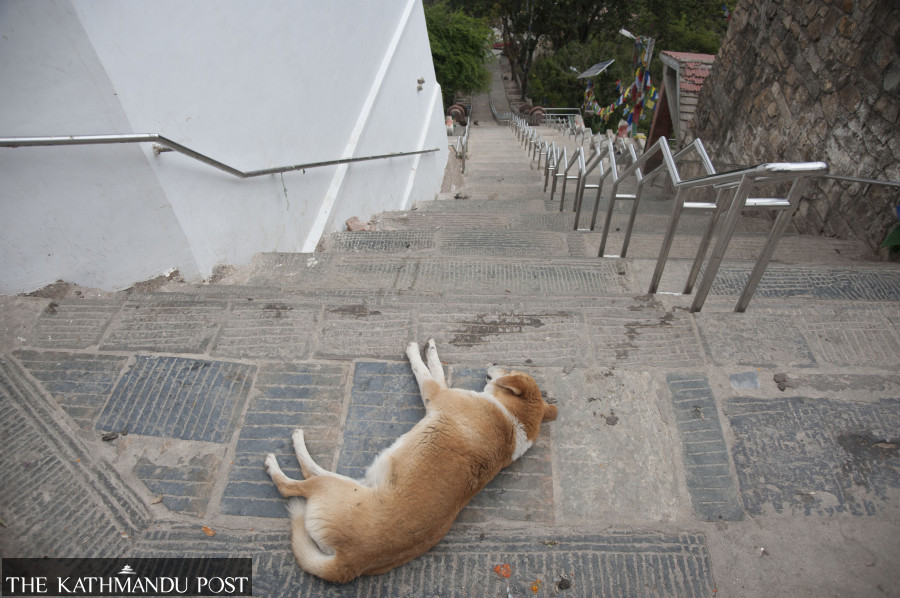Valley
Helping the dogs that don’t have anyone to look after
The canines on the streets are often subjected to torture and mistreatment, and some organisations have come forward to help them.
Aakriti Ghimire
About three years ago, Aama—a female dog—gave birth to six puppies on the outskirts of Kathmandu Valley.
What should have been a cause for celebration became a battlefield for the locals.
Aama’s five puppies were buried alive by some of the locals.
Traumatised, a few animal lovers in the locality reported the atrocity to Animal Nepal—a non-profit organisation working in animal welfare.
Overnight, Aama and one of her pups—Chhori—that had survived the ordeal were rescued and brought to Animal Nepal’s treatment centre at Chobhar, Kathmandu.
“Unfortunately, Chhori passed away. We couldn’t save her,” says Radha Gurung, who has been working at Animal Nepal since 2018. “Aama was extremely weak when she was brought to us, but she is healthy now.”
Aama’s case, however, isn’t an isolated incident.
Many community dogs across Nepal are unsafe in their own localities. Social media is rife with evidences of animal cruelty—from beating local dogs to death, to hanging them or throwing them off cliffs.
Despite legislation in place against animal cruelty, animal rights activists find that the laws aren’t effectively implemented. Alongside legal and bureaucratic hurdles, activists also have to deal with emotional struggles while working in the sector. Given the increasing evidence of atrocities against community dogs, advocates emphasise the need for dog population management mechanisms.
“There was a case where a man in Lalitpur hanged a dog to death. When we went to file a case, we were met with a lot of confused faces,” says Gurung. “Everytime we go to the police with a case, they think we are a bunch of lunatics with nothing better to do in our lives.”
While Nepal is lauded internationally for Kukur Tihar—a festival that worships dogs—videos of atrocities against dogs surface time and again on social media, evidencing the barbaric nature of some in the country.
“There’s a duality to Nepal’s animal culture. While we have Kukur Tihar, we still fall behind in animal welfare laws. In a recent video, a government official in Bardiya is seen beating a dog to death,” shares Sneha Shrestha, the founder of Sneha’s Care, an animal welfare organisation.
Advocates of rights for community dogs find the laws insufficient. Acts construing cruelty against non-working animals including dogs have not been clearly defined under the law.
While the law is comprehensive for animals in occupational sectors, it does little to ensure welfare and protection from cruelty for community dogs despite their numbers.
The Ministry of Livestock Development issued the Animal Welfare Directive in 2016 under the Animal Health and Livestock Services Act, 2055 to ensure welfare and prevent cruelty to animals.
However, the Directive is limited in its scope to “working animals” – animals used in commercial, agricultural, industrial or occupation sectors – and does not encompass domesticated animals such as dogs.
In 2017, the Criminal (Code) Act was adopted that states, “No person shall subject any animal or bird to torture by beating or hitting it.”
Breaching this law can result in imprisonment not exceeding three months or a fine not exceeding Rs 5,000.
On seeking justice against such atrocities against dogs at the police stations, animal rights activists are met with perplexed faces and the animal cruelty is either completely dismissed or invisibilised.
“Every time we approach the police or the relevant authorities, we are met with questions such as—are these your domesticated dogs? Why don’t you take them to your own home and treat them? What does it matter, it’s just a street dog,” said Shrestha.
This lack of awareness among the police about the extant laws on animal cruelty and the reluctance to implement them makes it difficult for activists to seek justice for dogs.
While many police officers dismiss such cases, there are some officers who are receptive to animal rights activists, says Gurung.
“They are willing to learn and often thank us for educating them on laws against animal cruelty,” shares Gurung.
Violence against dogs, however, isn’t limited to local community dogs but extends to domesticated breed dogs as well.
On February 14, Shrestha celebrated her pet dog Zara’s eighth birthday, even though she passed away a few years ago.
“Zara was poisoned by my neighbour. And she was supposed to be safe within the compounds of my house. But she wasn’t. If my own dog isn’t safe, I can’t imagine the threat that our local community dogs face,” says Shrestha.
Shrestha’s personal loss and her battle with depression following the incident pushed her towards establishing a full-fledged organisation working for animal welfare.
Shrestha initially began feeding street dogs in 2014. During her feeding trips, she noticed wounded and injured dogs—some with infected wounds, some still bleeding, some limping. She began taking such dogs to private veterinary hospitals and within a month she had managed to treat 50 dogs at her own expense.
Sneha’s Care at Karyabinayak is currently home to 167 dogs, 18 cows, seven pigs, five goats, and two buffaloes. Additionally, they provide anti-rabies vaccinations, treatment to wounded dogs, and are engaged in creating awareness against animal cruelty to school children.
Both Animal Nepal and Sneha’s Care have been providing shelter and treatment to local community dogs.
There are 53 dogs in Animal Nepal’s treatment centre. While Animal Nepal wasn’t established as an animal shelter, it now shelters many vulnerable dogs at its treatment centre in Chobhar.
“Our agenda is to relocate the treated dogs to their localities. However, many dogs are vulnerable in their localities and need a new home. Hence, they are here with us,” according to Rajita Budhathoki, administrative and communications officer at Animal Nepal.
From conducting vaccination drives to neutering dogs for their population management, both the organisations have resident caretakers, veterinary doctors and technical staff available regularly.
Oftentimes locals complain of dogs howling at night and causing disturbances. But that should not be a cause to be violent towards them, animal lovers say. The resolution should instead be implementing dog population management programmes.
“One of the major reasons why humans are violent towards dogs is to get rid of them. So if we want to reduce the number of puppies being buried alive or beaten to death, we have to focus on effective and regular dog population management,” says Gurung.
There are 20 non-governmental organisations (NGOs), like Sneha’s Care and Animal Nepal, currently working for animal welfare in Kathmandu Valley. NGOs often collaborate with the metropolitan cities to conduct dog population management programmes.
Kathmandu Metropolitan City (KMC) in 2016 introduced Manumitra, a dog management programme that provides birth control services, anti-rabies vaccination and rapid response for rabies control to community dogs, in collaboration with Humane Society International and Jane Goodall Institute Nepal.
Manumitra conducts an annual survey of street dogs in Kathmandu, and the most recent survey found there to be 22,000 community dogs in KMC alone, according to Dr Bikash Shrestha, the veterinary coordinator at Manumitra clinic.
KMC also introduced new taxation rules in 2020 for pet owners as a means of managing community dog populations.
Lalitpur Metropolitan City (LMC) recently concluded a dog population management and vaccination drive in wards 28 and 29.
“We castrated and administered anti-rabies vaccines to 57 dogs this fiscal year. Last year, we castrated 65 dogs,” said Dr Amar Raya, livestock development officer at LMC.
Working in the sector of animal welfare can be emotionally draining, say activists and workers in the field. Both government employees and independent activists share experiencing emotional fatigue and frustration as they witness animal cruelty and face various bureaucratic and legal hurdles while seeking justice for the animals.
“Working in this sector comes with its own trials and tribulations. Somedays, I am extremely frustrated at the system and the lack of empathy in humans, and I want to leave everything and run away,” says Shrestha.
Despite such exhaustion, the activists’ love for animals motivates them to continue advocating for their welfare and rights.
“Then again, everytime I go to the shelter and all those dogs wag their tails as they see me, I’m reminded of why I do what I do. The dogs can’t verbalise their pain and concerns to us, so there has to be people who will advocate for them. They motivate me to stay and continue the work at Sneha’s Care,” Shrestha said.
Animal activists have long been urging people to adopt their local community dogs instead of buying breed dogs.
“People are always seeking breed dogs while neglecting the strays in their community. These dogs are quite the same as bred ones. All they want is love and a home,” says Shrestha. “Our motto should be—don’t shop, adopt.”




 7.12°C Kathmandu
7.12°C Kathmandu











